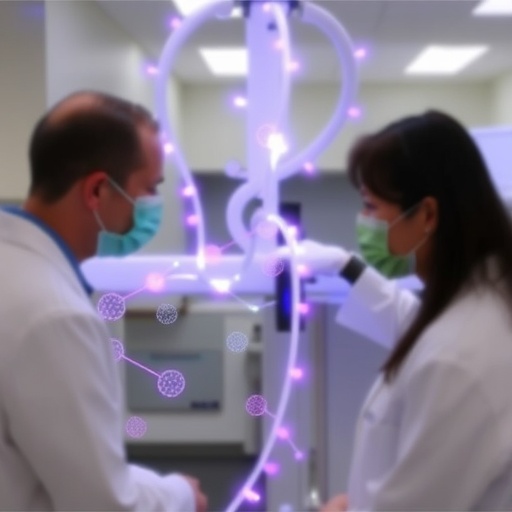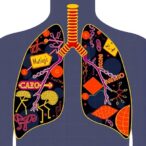
In a groundbreaking multicenter retrospective study published in BMC Cancer, researchers have delved into the crucial question of how young patients with extensive-stage small cell lung cancer (ES-SCLC) respond to first-line chemoimmunotherapy. This investigation, spanning nearly a decade and involving a cohort of 347 patients from multiple institutions, sheds new light on survival outcomes and safety profiles, challenging current perceptions about the therapeutic benefits in younger demographics.
Small cell lung cancer (SCLC) is notoriously aggressive, representing approximately 15% of all lung cancer diagnoses globally. Among these, the extensive-stage variant marks a particularly advanced and difficult-to-treat phase, characterized by widespread metastasis and poor prognosis. Chemoimmunotherapy, a therapeutic regimen combining chemotherapy with immune checkpoint inhibitors, has emerged as the frontline treatment for ES-SCLC in recent years, owing to its potential to improve overall survival. However, the efficacy and safety of such treatment across different age groups, particularly younger patients, remain insufficiently understood.
The study at hand stratified patients into two distinct age cohorts: young patients aged 45 years or younger, and a control group aged between just over 45 and 75 years. This distinction allowed researchers to compare survival outcomes—specifically progression-free survival (PFS) and overall survival (OS)—while also evaluating the incidence of adverse events associated with treatment. Notably, this analysis is one of the rare large-scale investigations focusing specifically on younger ES-SCLC patients undergoing chemoimmunotherapy.
.adsslot_8Zk6sGhvBQ{width:728px !important;height:90px !important;}
@media(max-width:1199px){ .adsslot_8Zk6sGhvBQ{width:468px !important;height:60px !important;}
}
@media(max-width:767px){ .adsslot_8Zk6sGhvBQ{width:320px !important;height:50px !important;}
}
ADVERTISEMENT
Remarkably, young patients exhibited significantly poorer survival outcomes compared to their older counterparts. Median progression-free survival in the young group was a mere 4.67 months, contrasting with 5.40 months in the control group. Similarly, overall survival was shorter for younger patients, with a median of 13.7 months versus 14.4 months in the older group. These differences, while numerically subtle, reached statistical significance, underscoring the robustness of the findings.
Diving deeper, when the focus narrowed strictly to those receiving chemoimmunotherapy, younger patients again fared worse than the control group. The median PFS for young patients in this subset was 4.50 months, compared to 5.57 months for older patients, while OS registered at 13.20 months versus 15.33 months, respectively. This reveals not only an age-related discrepancy but also raises critical questions about the presumed universal benefit of chemoimmunotherapy in ES-SCLC.
Further compounding the concern, within the young cohort itself, chemoimmunotherapy did not outperform chemotherapy alone. There was no significant difference in median PFS (4.50 vs. 5.75 months) or OS (13.20 vs. 13.70 months) between the two treatment strategies for younger patients. This finding suggests that the addition of immunotherapy might not confer the expected survival advantages in younger individuals, a stark contrast to the observed benefits in the broader ES-SCLC population.
The safety profile of chemoimmunotherapy in younger patients also merits attention. The incidence of immune-related adverse events (irAEs) was markedly higher in the young group, affecting 30.51% of patients, compared to just 11.46% in controls. These irAEs, which can range from mild skin reactions to severe pneumonitis and colitis, manifest as the immune system erroneously targeting healthy tissues and can complicate clinical management significantly.
Moreover, hematologic toxicities were more prevalent in the younger cohort. Thrombocytopenia, a dangerous condition characterized by low platelet counts leading to increased bleeding risk, was observed in 25.42% of the younger patients versus 14.24% in older ones. Such side effects not only affect quality of life but can also limit treatment dosages and schedules, potentially influencing overall treatment efficacy.
The mechanisms underlying these outcomes are far from definitive but open compelling avenues for future research. Younger patients might possess distinct tumor biology, immune microenvironments, or pharmacogenomic profiles that modulate responsiveness to chemoimmunotherapy. For instance, differences in tumor mutational burden, neoantigen expression, or immune checkpoint receptor profiles may influence therapeutic efficacy and toxicity.
This study’s retrospective design inherently limits causative conclusions but offers invaluable real-world insights from clinical practice beyond the controlled environments of clinical trials. The multicenter approach enhances the generalizability of findings across diverse patient populations and treatment settings, emphasizing the need for personalized therapeutic strategies in ES-SCLC based on age demographics.
Given these findings, oncologists must now grapple with the possibility that standard first-line chemoimmunotherapy regimens may require adaptation for younger ES-SCLC patients. There is an urgent need to delineate biomarkers predictive of benefit and toxicity in this subgroup to optimize treatment and mitigate risks. Clinical trials designed specifically for young patients or those incorporating novel immunotherapeutic agents could pave the way forward.
In addition to survival metrics, this study accentuates the importance of vigilant monitoring for immune-related adverse events and hematologic toxicities in younger patients receiving chemoimmunotherapy. Early recognition and management of these complications are paramount to avoid treatment discontinuation and preserve patient quality of life.
Ultimately, this research challenges the prevailing assumption that younger age invariably confers better cancer outcomes. In the aggressive landscape of ES-SCLC, younger patients may represent a vulnerable population with unique therapeutic challenges and risks. These findings underscore the necessity for nuanced, age-conscious oncology care that transcends one-size-fits-all treatment paradigms.
By illuminating these critical distinctions in treatment response and toxicity, the study sets a new course for clinical inquiry and therapeutic innovation. Addressing these disparities could stimulate the development of novel immunomodulatory strategies or combination therapies tailored to the biology of younger ES-SCLC patients, thereby improving their dire prognosis.
In conclusion, the multicenter retrospective analysis presents a compelling narrative: younger patients with ES-SCLC experience poorer survival and a higher burden of adverse events with first-line chemoimmunotherapy compared to their older peers. These findings implicate an urgent reassessment of therapeutic approaches in this subgroup and herald a new era of precision oncology in small cell lung cancer treatment.
As the oncology field continues to embrace immunotherapy as a cornerstone, understanding the demographic nuances of response and safety is essential. This study serves as a clarion call to the research community, urging intensified investigation into age-related differences and fostering personalized medicine to improve outcomes for all patients battling this devastating disease.
—
Article Title: Efficacy and safety of first-line chemoimmunotherapy in young patients with extensive-stage small cell lung cancer: a multicenter retrospective study
Article References:
Zhao, L., Xiong, Q., Long, Y. et al. Efficacy and safety of first-line chemoimmunotherapy in young patients with extensive-stage small cell lung cancer: a multicenter retrospective study. BMC Cancer 25, 1136 (2025). https://doi.org/10.1186/s12885-025-14524-y
Image Credits: Scienmag.com
DOI: https://doi.org/10.1186/s12885-025-14524-y
Tags: age demographics in cancer treatmentaggressive lung cancer treatment optionschemoimmunotherapy in young patientsextensive-stage small cell lung cancerimmune checkpoint inhibitors for lung cancermulticenter cancer research findingsoverall survival rates in SCLCprogression-free survival in lung cancerretrospective study on lung cancer treatmentsafety profiles of chemoimmunotherapysurvival outcomes in SCLCtherapeutic benefits for young cancer patients


